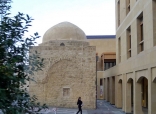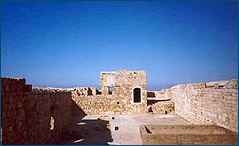| Random image |
 |

Downtown Beirut
|
 |
|
 |
 |
TRIPOLI
 Tripoli,
85 kilometers north of Beirut, is Lebanon's second largest
city, and known as the capital of the North. Tripoli,
85 kilometers north of Beirut, is Lebanon's second largest
city, and known as the capital of the North.
Tripoli is a city where modern and medieval blend, with a
number of historical sights including 12 mosques from
Mamluke and Ottoman periods and a Crusader Church along with
an equal number of madrassas or theological schools. Amongst
numerous other structures one of the most interesting
attractions are the old Khans and Souks which were
established close to 500 years ago and continue their trade
until today. Tripoli is also famous for its Hammams - public
baths - which date back as far as the 13th century and can
still be seen throughout the city today.
Forty - five buildings in the city, many dating from the
14th century, have been registered as historical sites. The
souks, together with the khan, form an agglomeration of
various trades where tailors, jewelers, perfumers, tanners
and soap-makers work in surroundings that have changed very
little over the last 500 years. Modern Tripoli is divided
into two parts: El - Mina ( the port area and site of the
ancient city ) and the town of Tripoli proper.
The medieval city at the foot of the Crusader castle is
where most of the historical sites are located. Surrounding
this is a modern metropolis which is occupied with commerce,
banking and recreation. The area known as "at-Tall",
dominated by an Ottoman clock tower (built in 1901/2) in the
heart of downtown. Just offshore is a string of small
islands. The largest, known as the Island of Palm Trees or
Rabbit's Island, is now a nature reserve for green turtles
and rare birds. Declared a protected area by UNESCO in 1992,
this island also holds Roman and Crusader remains.
Habitation of the site of Tripoli goes back to at least the
14th century B.C., but it wasn't until about the 9th century
B.C. that the Phoenicians established a small trading
station there. Later, under the Persians, it was home to a
confederation of the Phoenician city states of Sidon, Tyre
and Arados Island. Built on the trade and invasion route
near the Abu Ali River, Tripoli's strategic position was
enhanced by offshore islands, natural ports and access to
the interior. Under Roman rule, starting with the take-over
of the area by Pompey in 64 - 63 B.C., the city flourished.
During this period the Romans built several monuments in the
city. The Byzantine city of Tripolis, which by then extended
to the south, was destroyed, along with other Mediterranean
coastal cities, by an earthquake and tidal wave in 551.
After 635 Tripoli became a commercial and shipbuilding
center under the Omayyads. It achieved semi - independence
under the Fatimid Dynasty when it developed into a center of
learning. At the beginning of the 12th century the Crusaders
laid siege to the city, finally entering it in 1109. The
conquest caused extensive destruction, including the burning
of the Tripoli's famous library, the Dar Il- Ilm, with its
thousands of volumes. During the Crusader's 180 - years rule
the city was the capital of the "County of Tripoli." But
crusader Tripoli fell in 1289 to the victorious Mamluke
Sultan Qalaoun, who ordered the old port city (today Al -
Mina) destroyed and a new city built inland near the old
castle. It was at this time that the numerous religious and
secular buildings were erected, many of which still survive
today.
During the long Turkish Ottoman rule (1516 - 1918) Tripoli
retained its prosperity and commercial importance and in
these years more buildings were added to the city's
architectural wealth.
The Citadel (St Gilles Citadel)
In 698 AD. Prince Seyfedeen Asandamor Kourji underwent major
constructions in the city of Tripoli, and built part of the
St Gilles Citadel towering above Tripoli. Many secret
tunnels exist between the castle and inner market, with some
of them discovered only lately. The Citadel contains a
Fatimid mosque, the oldest Islamic monument in Tripoli
characterized by its octagonal shape with traces of a
minaret nearby. But the Crusaders destroyed the sanctuary
and converted it to a church.
Tower of Barsbay
The Tower of Barsbay is an example of the Mamlukes military
architecture rising at the edge of the water, in the second
part of the town. While most of the numerous coastal towers
and fortifications which protected Tripoli during Mamluke
times have disappeared or been encroached upon by modern
buildings, the mid-15th century Tower of Barsbay is still
remarkably preserved. The tower is characterized by a
rectangular base; 28.5 meters long and 20.5 meters wide. It
is actually a fortress of two storeys high with laufty
vaulted ceilings. The west portal is in the typical Mamluke
black and white (Ablaq) stone pattern. From the outside you
can see how the builders placed Roman columns horizontally
in the wall as reinforcements.
Located in the area of el-Mina, this fortress with walls two
meters thick and an imposing entrance, is well worth a
visit.
The Great Mosque
The Great Mosque was built on the 12th century Crusader
Cathedral of St Mary of the Tower. It has a large courtyard
surrounded by porticos and a vaulted prayer hall. The mosque
dates back to the Mamluke period and has elements of Western
architecture.
Old Quarter
The old quarter is a honeycomb of narrow streets and alleys,
souks, khans, mosques, islamic schools and shops, and an
example of Islamic architecture. Some of the souks, notably
the tailors' souk, are as many as 600 years old. Craftsmen
sit in narrow alcoves along the sides of the streets, hardly
bothering to look up from their work as tourists and
passersby move along. From the tailors' souk, one can walk
to the soap market, where the perfume of the vendors' wares
mingles with that of flowers in the garden courtyard; the
jewelers' souk backs onto the spice market, and so on.. The
most important thing to note here is that all these people
are working in surroundings that have changed very little
over the last 500 years. Many khans lie within the urban
periphery of the old city. The Khan al-Misriyyin
(caravansary of the Egyptians), probably built in the first
half of the 14th century, is in the traditional arcaded
two-story style. It has an open courtyard with a fountain in
the center.
Khan al-Khayyatin or Tailors' Khan is one of the oldest and
dates to the first half of the 14th century. It is said that
it was built on the remains of a Byzantine and Crusader
structure. This Khan has a different plan from the others.
It consists of a long passageway with tall arches on each
side and ten transverse arches. Just at its western entrance
stands a granite column marble Corinthian capital. One of
the oldest in Tripoli, the, dates to the first half of the
14th century and was probably built on the remains.
Khan es-Saboun (soap warehouse), built in the second half of
the 16th century or the beginning of the 17th century, was
originally a caravansary for European merchants. During the
first half of the 20th century it was converted into a
warehouse. A large, rectangular structure, it has two
stories of arcaded corridors around a courtyard.
Khan al-Askar, or soldiers' khan. Consisting of two main
buildings joined by a vaulted passage, it was probably
erected in the late 13th or early 14th century for Mamluke
troops. The two courtyards are surrounded by two stories of
rooms behind arcaded corridors.
Souk Al-Haraj, a 14th century covered bazaar supported by 14
classical granite columns.
|